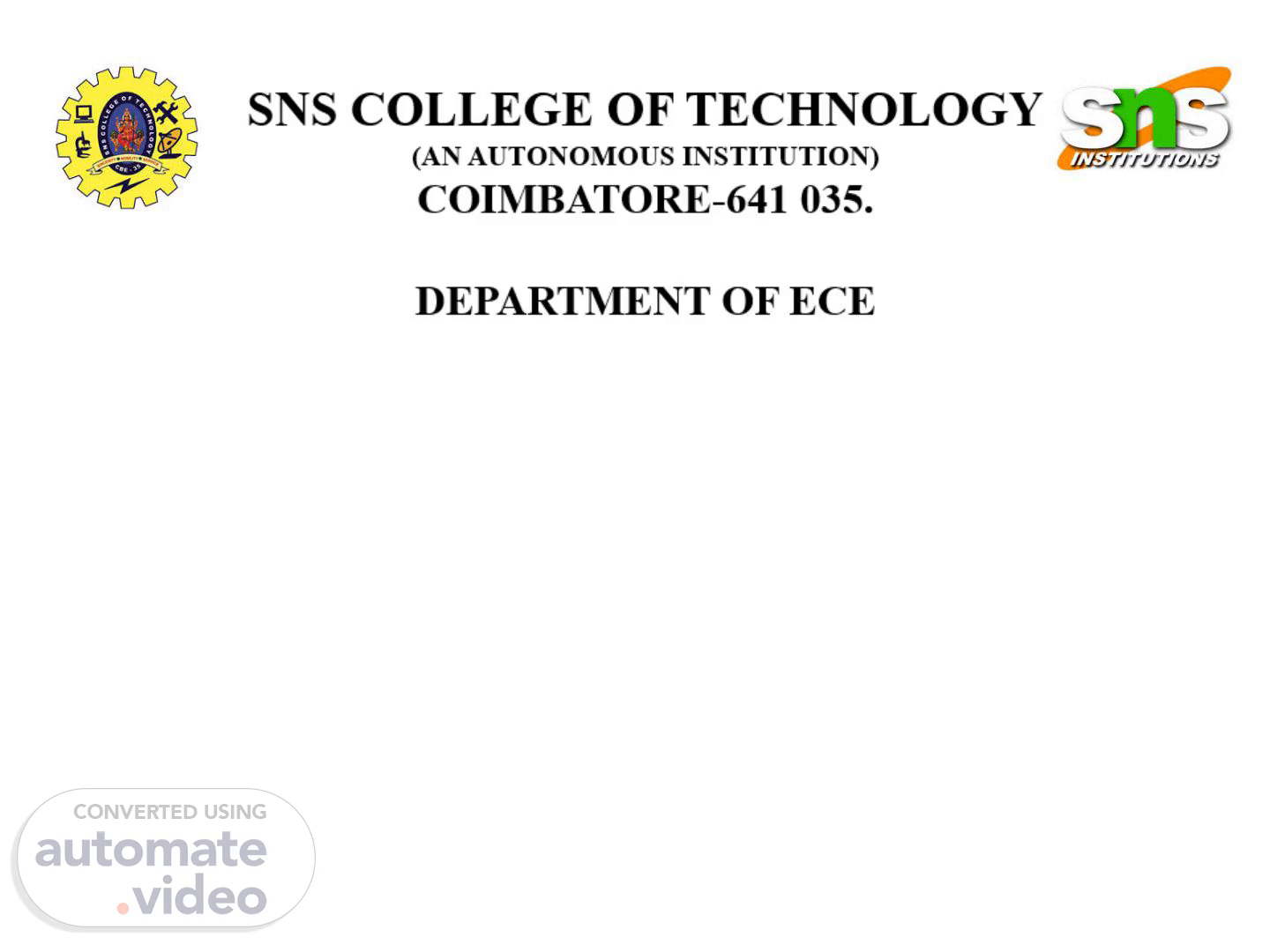
SNS COLLEGE OF TECHNOLOGY (AN AUTONOMOUS INSTITUTION) COIMBATORE-641 035. DEPARTMENT OF ECE
Scene 1 (0s)
SNS COLLEGE OF TECHNOLOGY (AN AUTONOMOUS INSTITUTION) COIMBATORE-641 035. DEPARTMENT OF ECE.
Scene 2 (24s)
20/11/2024. 2. SNS College of Technology/IV ECE C/ BATCH 03.
Scene 3 (39s)
20/11/2024. 3. SNS College of Technology/IV ECE C/ BATCH 03.
Scene 4 (49s)
20/11/2024. 4. SNS College of Technology/IV ECE C/ BATCH 03.
Scene 5 (1m 8s)
20/11/2024. 5. SNS College of Technology/IV ECE C/ BATCH 03.
Scene 6 (1m 47s)
20/11/2024. 6. SNS College of Technology/IV ECE A/ BATCH 03.
Scene 7 (2m 21s)
20/11/2024. 7. SNS College of Technology/IV ECE A/ BATCH 03.
Scene 8 (2m 56s)
20/11/2024. 8. SNS College of Technology/IV ECE C/ BATCH 03.
Scene 9 (3m 14s)
EXISTING METHOD DESCRIPTION. Use a high-bit-depth phase accumulator (32-48 bits) paired with a stable, low-jitter clock source to achieve fine frequency resolution and minimize phase noise. Employ a high-resolution DAC with a clock synchronized to the NCO to ensure smooth digital-to-analog conversion and reduce jitter. Use phase dithering to minimize spurs and apply a low-pass filter after the DAC to further reduce high-frequency noise and improve signal purity..
Scene 10 (3m 39s)
20/11/2024. SNS College of Technology/IV ECE C/ BATCH 03.
Scene 11 (3m 58s)
PROPOSED METHOD DESCRIPTION. This Direct Digital Synthesizer (DDS) system generates precise RF signals by using a Frequency Control Word to set the desired frequency, which the Phase Accumulator converts to a digital phase signal. This phase is mapped to a waveform amplitude via a Sine/Cosine Lookup Table and converted to an analog signal by the Digital-to-Analog Converter (DAC). A Clock System governs the timing, while a Low Pass Filter removes unwanted frequencies, producing a clean, stable RF Output Signal for communication and signal processing applications..
Scene 12 (4m 25s)
RESULTS AND DISCUSSION. The NCO-based frequency generator offers high accuracy, low power consumption, and stable frequency outputs, making it ideal for portable RF testing. It produces minimal phase noise and spurious emissions, though some filtering may be needed for harmonic content. The generator supports various modulation schemes, making it versatile for communication system testing. Overall, it's an efficient solution, but further optimization may be required for sensitive applications with strict phase noise and emission needs..
Scene 13 (4m 50s)
RESULTS. Applications Eile Edit Places Waveform 1 - SimVision Waveform 1 - SimVision Explore Format Simulation Yindows Help Tue 13:18 • I Search Times: Value Search Names: Signal ooons 1 zoons Console 1400ns - SimVi„. 600ns L I Time laoons "Cursor-Bas4ne• = 21 Ins Name reset sir _OLt(7 I(S6) WhatsApp — Cursor zoons 0064 student@c2s:rtl Time oons toons 800ns 03zS zooons ODES cädence- 2400ns 1 object selected NCLaunch : /ho„. Design Browser Waveform 1.
Scene 14 (5m 9s)
RESULTS. Applications Places Waveform 1 - SimVision Eile Edit Yiew Explore Format Simulation Yindows Help Search Names. Signal Search Times: Value— TimeA. Ctnor-aaselne• 2575m Tue 13:17 • Waveform 1 - SimVision Name phase Sc [91 m-•ß• phase Sc [81 phase _"[71 . phase SC [61 phase [41 : phase_nc reset sin_outpl sin_outEl sin_out51 sin_outßl sin_outßl sin_outpl 1 j [(S6) WhatsApp rsor 1 oons student@c2s:rtl 300ns cons SOOns 600ns Design Browser 700ns eoons 118 Console goons -49 - SimVim 1000ns -so 1800 1 loons 1 zoons -49 0 2200 1300ns -so cädence- 1400ns 2S7Sns 10 objects selected NCLaunch tho Waveform 1 - Sim.
Scene 15 (5m 30s)
CONCLUSION. The NCO-based frequency generator delivers accurate and stable RF signals with precise frequency control, ideal for testing applications. The system ensures minimal phase noise, providing clean signals necessary for reliable RF component testing. It offers flexible frequency adjustment through digital controls, making it adaptable for various RF testing scenarios..
Scene 16 (5m 50s)
FUTURE WORK. Develop higher-bit phase accumulators for more precise frequency control. Improve clock stability and use high-quality DACs to reduce phase noise. Implement advanced filtering techniques to minimize harmonic content and improve signal purity. Enhance accuracy and responsiveness in adjusting output frequencies in real-time..
Scene 17 (6m 9s)
20/11/2024. 17. SNS College of Technology/IV ECE C/ BATCH 03.
Scene 18 (6m 44s)
20/11/2024. 18. SNS College of Technology/IV ECE C/ BATCH 03.